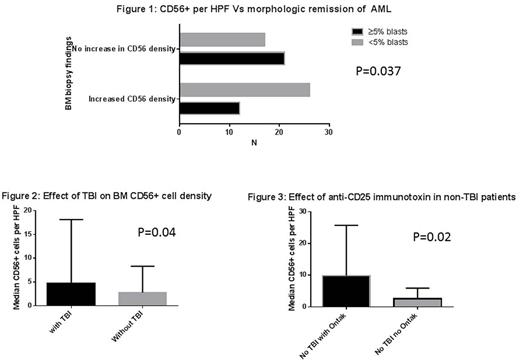Abstract
Background: Natural killer (NK) cells are innate lymphoid cells capable of killing leukemic cells without prior sensitization. Adoptive immunotherapy with allogeneic NK cells has been used at the University of Minnesota and was shown to be effective in a subset of patients with acute myeloid leukemia refractory to therapy. The factors determining clinical success of adoptive NK cell immunotherapy are largely unknown. We hypothesized that NK cell homing and persistence in the bone marrow niche may be predictive for the clinical outcomes.
Methods: We retrospectively analyzed bone marrow biopsy findings 14 days after NK cell infusion in 109 patients treated at our institution between 2003-2014. To evaluate the homing and persistence of NK cell in the bone marrow, multiple methods were used. Immunohistochemical staining for the NK cell marker CD56 was performed on the core biopsy in available cases. Flow cytometry data performed on aspirate material at the time of the biopsy was re-evaluated to enumerate the NK cell percentage. Finally the percentage of Large Granular Lymphocytes was determined in a semi-quantitative manner from Wright-Giemsa stained aspirate smears. CD56 immunohistochemical stain was quantified by counting the number of CD56 positive cells per microscopic field of view (High Power Field, HPF) (400 x magnifications) and averaging over the 10 microscopic fields with the highest density of CD56 positive cells. Cases with obvious CD56 staining of blasts on the trephine core were excluded from further analysis.
Results: 95 bone marrow biopsy cases could be stained for CD56, but 6 cases were excluded from analysis due to CD56 staining leukemic blast population. For the whole study group the average CD56+ cell density per High Power Field (HPF) was 10.1 (SD=17). A control group composed of 10 patients with bone marrow biopsy shortly after chemotherapy, but who did not receive NK cell infusion had an average of 3.8 CD56+ cells per HPF (SD=3.4).
Patients who had a higher density of NK cells in the bone marrow compared to the control group (more than 3.8 cells/HPF) were less likely to have persistence of acute leukemia as defined by ≥5% blasts, than patients with an NK cell density similar to the control group (Figure 1, Chi-square test, p=0.037). As well, patients with <5% leukemic blasts had more CD56 positive cells per HPF (Median 5.6, range 0.1-95.8 Versus median 1.8, range 0.1-28.1, p=0.009, Mann-Whitney test) and had a greater proportion of NK cells by flow cytometry (p=0.004, Mann-Whitney test).
The clinical factors which may affect NK cell homing and persistence were also evaluated. Total Body Irradiation (TBI) at a dose 200 cGy for 2 days was applied as part of pre-infusion conditioning in a subset of the patients. Patients who received TBI (32 with TBI Vs 55 without) had a significantly higher density of CD56 positive cells (Figure 2, Median 4.75Vs 2.8, p=0.04, Mann-Whitney test). Among those patients who did not receive TBI conditioning, a subset received an anti-CD25 immunotoxin agent to reduce regulatory T cells (Denileukin Difitox, Ontak). The density of NK cells was significantly higher in the patients who received anti-CD25 immunotoxin (Figure 3, Median 9.8 Vs 2.5, p=0.02, Mann-Whitney test).
Conclusions: Homing and survival/expansion of adoptively transferred NK cells in the bone marrow 14 days after infusion correlates with morphologic remission of acute leukemia. While the factors influencing NK cell homing and persistence in the BM niche remain to be elucidated, our results suggest a role for TBI as part of the conditioning and anti-CD25 immunotoxin in promoting the persistence of adoptively transferred NK cells in the bone marrow niche.
Miller: Oxis Biotech: Consultancy; Fate Therapeutics: Consultancy, Research Funding; Celegene: Consultancy.
Author notes
Asterisk with author names denotes non-ASH members.


